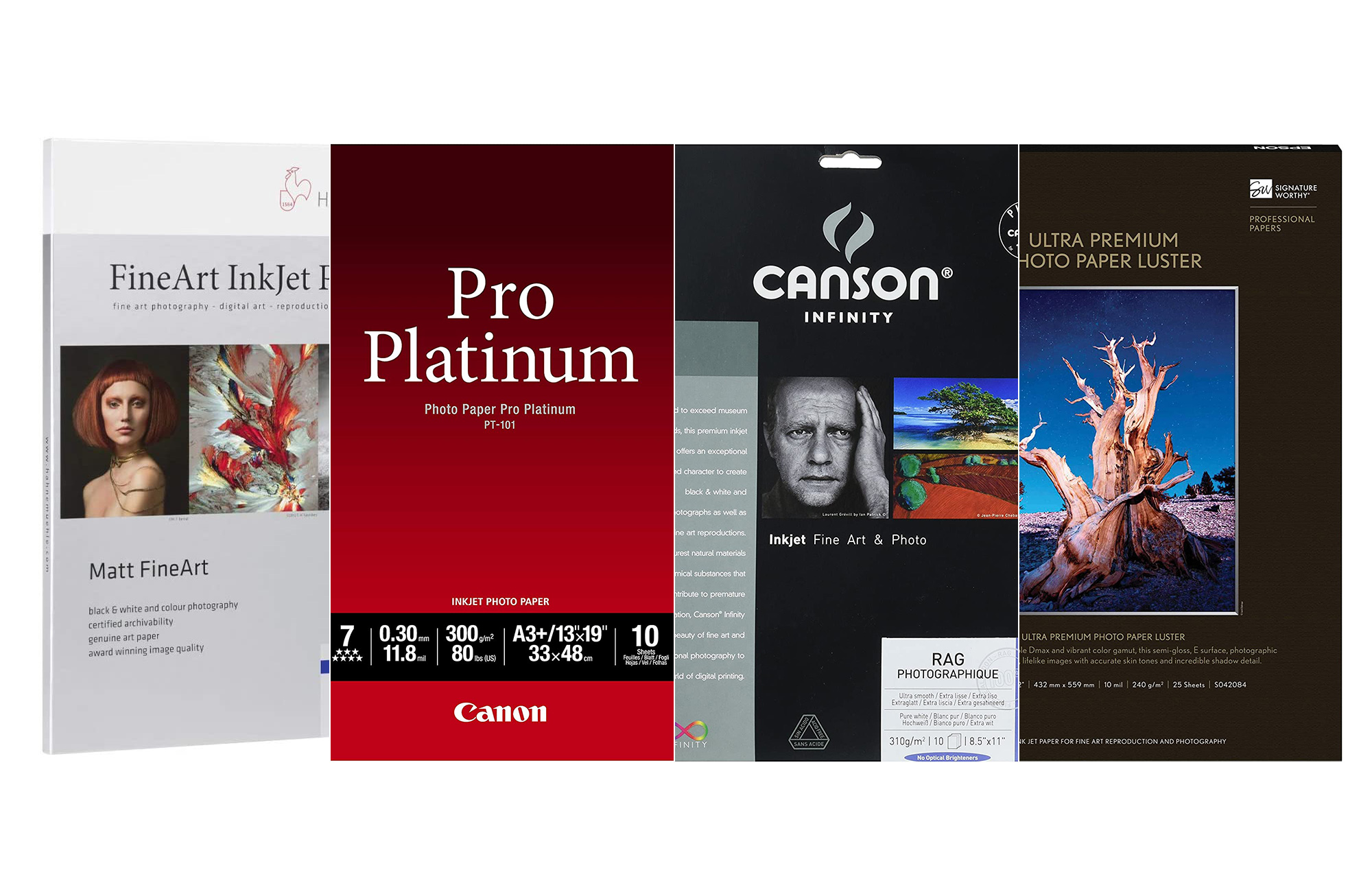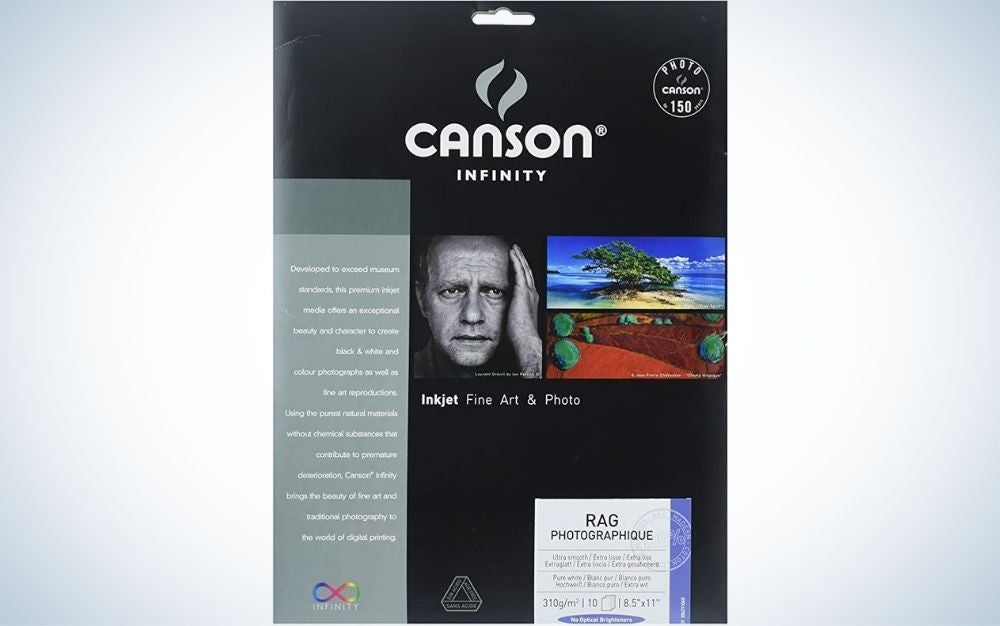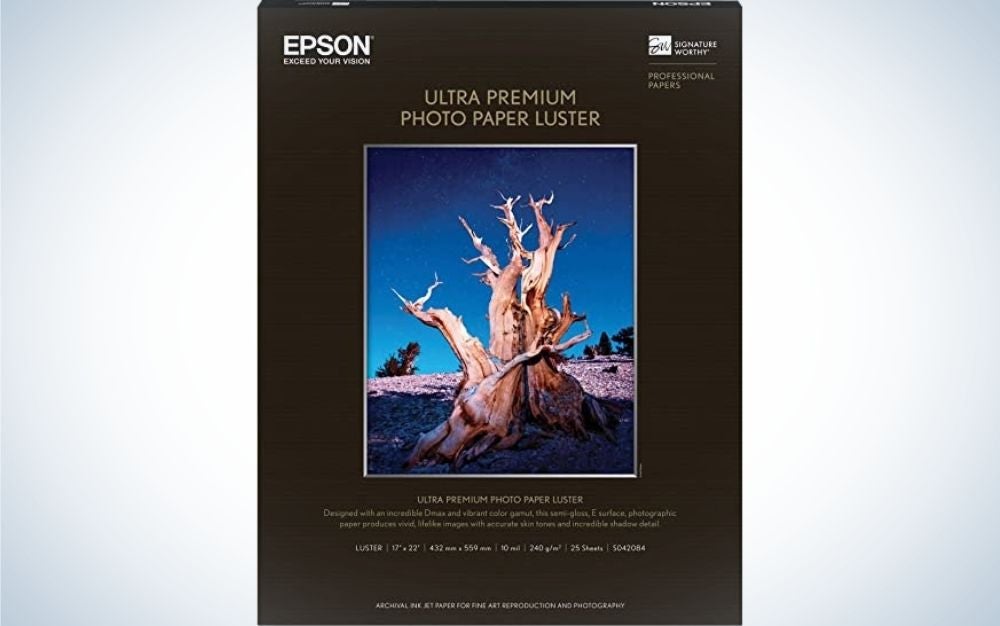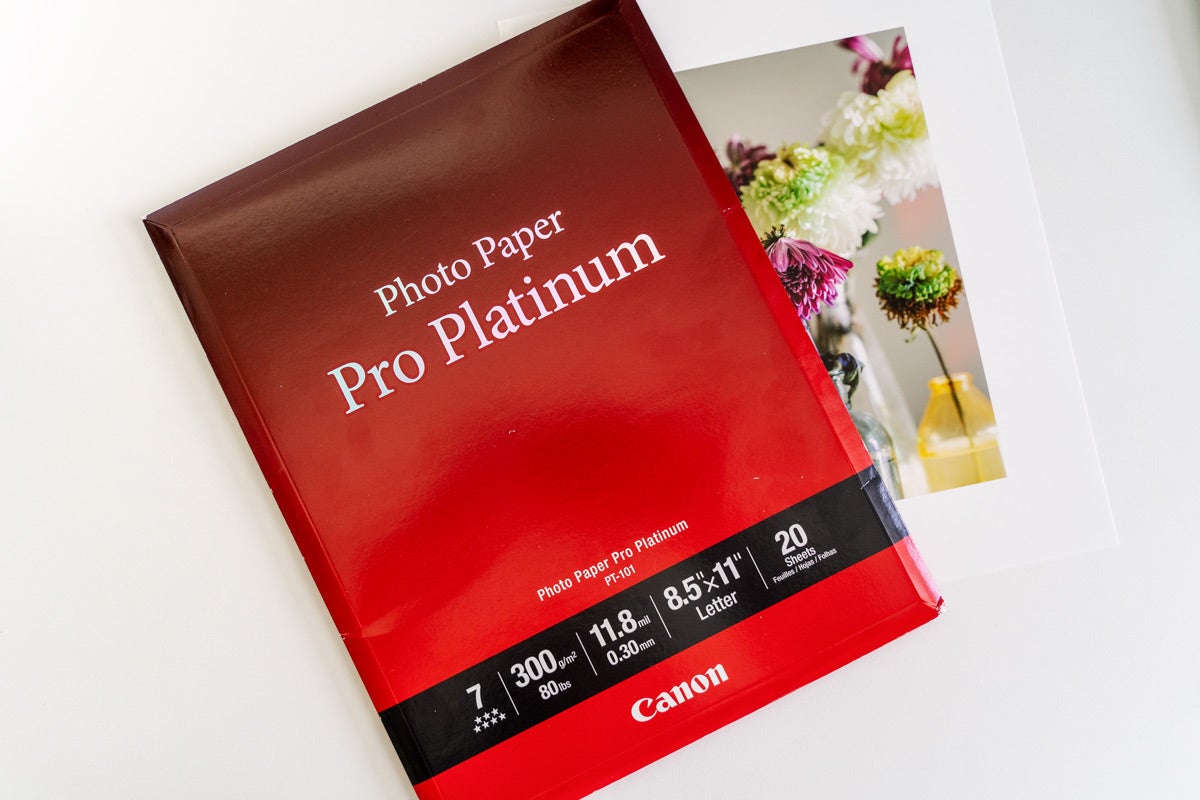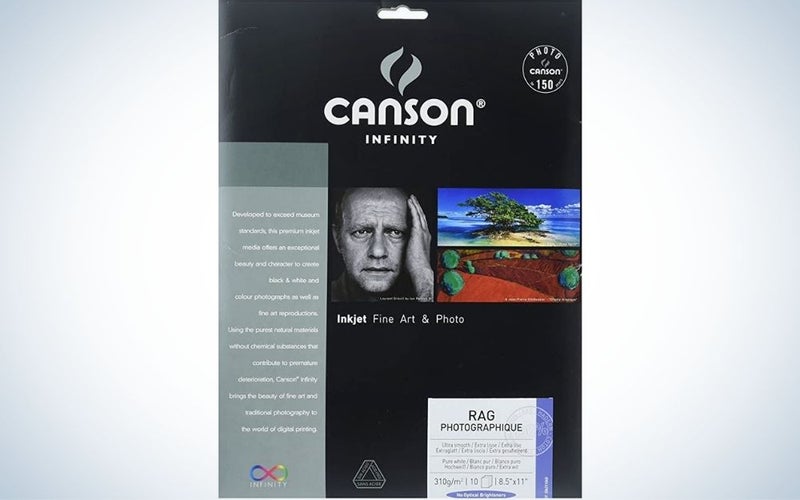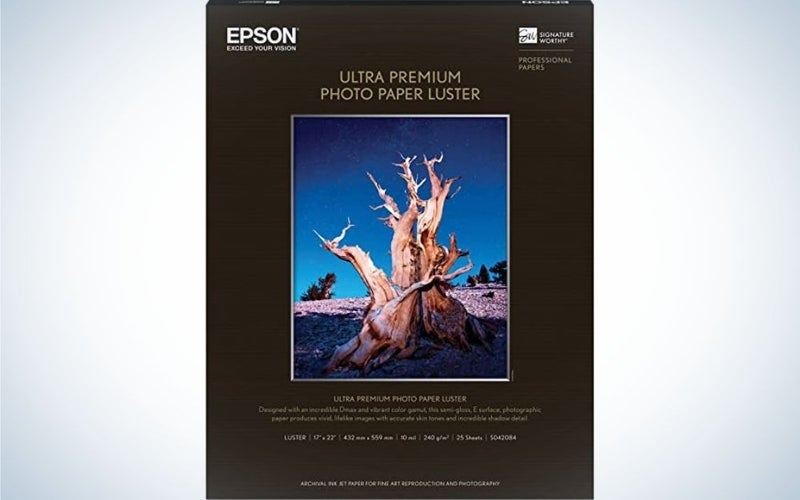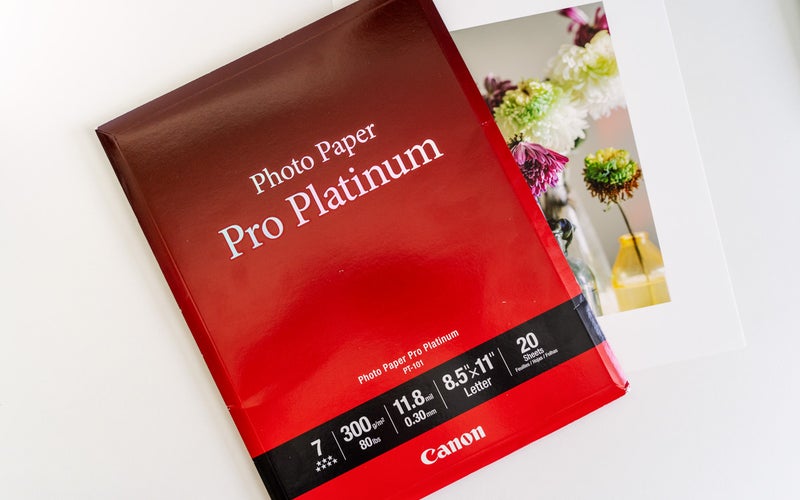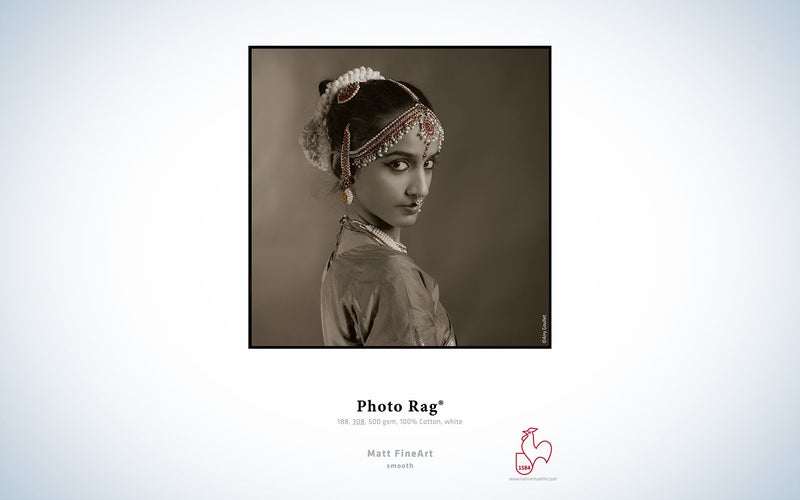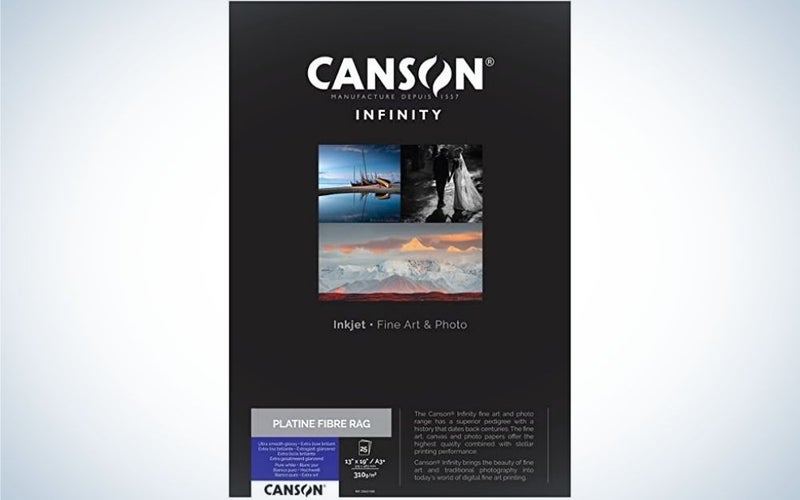We may earn revenue from the products available on this page and participate in affiliate programs. Learn more ›
When it comes to printing photographs, photo paper tends to take a back seat to printers. While a quality printer is absolutely essential, the photo paper you choose will have a profound impact on how the final image looks in your hands or on the wall. With a wide range of paper types, you can drastically alter your images just with paper selection alone. The best photo paper will give you quality colors and exceptional detail, making your prints sure to impress.
- Best matte: Canson Infinity Rag Photographique Matte
- Best for framing: Epson Ultra Premium Luster
- Best glossy: Canon Photo Paper Pro Platinum
- Best for art prints: Hahnemühle Photo Rag 308 gsm
- Best for black and white: Canson Infinity Platine Fibre Rag 310gsm
How we picked the best photo paper
The writers and editors have decades of experience in nearly every genre and area of photography. I have been printing my own photographs or dealing with commercial printers for around ten years. I have tested many different paper options and printer-specific results during that time. When selecting the papers for this list, I relied on that hands-on experience, as well as the experience of photographers I know. Every photographer and subject matter has different needs and tastes, so I focused on a range of styles and finishes to fit. I looked at weight, thickness, brightness, OBAs, and the range of size options for all papers. Finally, I also chose options from different brands to cover a broader spectrum of papers.
The best photo paper: Reviews & recommendations
Whether you are an artist printing photos for galleries or a portrait photographer selling prints to clients, the right photo paper can make all the difference. The options below are ideal for a range of photographers and types of photographs, so you’re sure to find something that works for you.
Best matte: Canson Infinity Rag Photographique Matte 310 gsm
Canson
Specs
- Sheet size options: 8.5 x 11 inches, 11 x 17 inches, 13 x 19 inches, 17 x 22 inches
- Roll size options: 17” x 50’, 24” x 50’, 36” x 50’, 44” x 50’, 60” x 50’
- Base material: 100% Cotton rag
- Whiteness: 89.8%
- Weight: 310 gsm
- Thickness: 18.3 mil
Pros
- Available in 210 or 310 gsm
- Available as one or two-sided
- Wide selection of sizes in sheets or rolls
- Archival quality
Cons
- Pricey for everyday users
- Must search at specialty stores for most sizes
Canson is one of the higher-end paper producers and has been making quality photo paper for a long time. Many photographers prefer the look and feel of matte paper, and the Infinity Rag Photographique Matte is one of the best. It comes in 210 and 310 gsm and has an extensive range of sizes, both in sheet and roll form. With their largest roll, you can print up to 60 inches on the short side, which is massive.
Both weight options have a nice heft, making them sturdy enough to stand up to some large print sizes (still with delicate handling, of course). It produces some rich blacks and highly accurate colors, as long as you are using quality inks and a color-calibrated monitor, that is. It has excellent whiteness without any OBAs, meaning it is fully archival and museum-quality. When handled well, your prints will last for a very long time.
Best for framing: Epson Ultra Premium Luster
Epson
Specs
- Size options: 8.5 x 11”, 13 x 19”, 11.7 x 16.5” (A3)
- Base material: Alpha cellulose
- Brightness: 97%
- Weight: 240 gsm
- Thickness: 10 mil
Pros
- Vivid, accurate color
- Dries instantly
- Ideal finish for framing
- Available in packs with up to 250 sheets
Cons
- Not a huge selection of sizes
- Not available in rolls
The Epson Ultra Premium Luster paper has been my go-to paper choice for years, especially when I know I will be framing a print behind glass. The luster finish has some gloss, 16 percent at 60° to be precise, to produce rich colors and contrast, but it is subtle enough that you don’t have to contend with much glare. That opens up the possibilities of where you can hang the print as well.
Unfortunately, this paper only comes in four size options. It is also not available in rolls, so you will need to keep reloading your paper feeder if you print a lot. But the Ultra Premium Luster paper has 97 percent opacity, meaning some light will shine through the paper, giving nice depth if hung without mounting of any sort. It also dries instantly after printing, so you don’t have to worry about accidentally touching the print when taking it away from the printer (just watch for fingerprints).
Best glossy: Canon Photo Paper Pro Platinum
Abby Ferguson
Specs
- Sheet size options: 4×6″, 8.5×11″, 11×17″, 13×19″, 17×22″,
- Roll size options: 17” x 100’, 23” x 100’, 36” x 100’, 42” x 100’
- Base material: Not provided
- Brightness: 98%
- Weight: 218 gsm
- Thickness: 11.8 mil
Pros
- Ultra-glossy for gloss lovers
- Available in sheets and rolls
- Lots of size options, including small sizes
- Vivid colors
Cons
- Roll options not widely available
- Color profiles can be finicky if not using Canon printers
The Canon Photo Paper Pro Platinum is part of Canon’s high-end line, though the price doesn’t reflect that. It is an affordable paper, especially given the quality. The Platinum paper is an ultra-high gloss offering with a gloss level of 35 percent at 60 degrees. The high level of shine and 98 percent brightness will help produce incredibly rich color and deep contrast, making it ideal for images that you want to have some extra pop when printed.
The Platinum paper comes in a good range of sizes in sheets and quite a few roll options for when you want to print really large. The rolls are only available on specialty photography websites, however, such as Adorama.
Canon has specifically designed this to be used with its printers, in this case, the PIXMA line. When used with the ChromaLife100+ inks, Canon says prints will have a life of over 200 years. That doesn’t mean that you can’t use it with other printers, but you won’t have a pre-loaded ICC profile (a specific guide for a printer that accounts for the printer, ink, and paper combination for accurate color). You will have to download a profile from Canon’s website and install it or do some testing to find the best built-in option.
Best for art prints: Hahnemühle Photo Rag 308 gsm
Hahnemuhle
Specs
- Sheet size options: 8.5 x 11”, 11 x 17″, 13 x 19”, 17 x 22”, 24 x 30″ 24 x 36″, 35 x 46.75″
- Roll size options: 17” x 39’, 24” x 39’, 36” x 39’, 44” x 39’, 44″ x 65′
- Base material: Cotton rag
- Brightness: 90%
- Weight: 308 gsm
- Thickness: 18.8 mil
Pros
- Available in 188, 308, or 500 gsm
- Roll and sheet options
- Single and double-sided options
- Acid- and lignin-free for excellent age resistance
- Beautiful texture
Cons
- Expensive for the everyday user
For photographers producing high-end fine art prints, Hahnemühle papers are some of the absolute best options available. The Photo Rag Matte option has excellent weight and thickness, resulting in sturdy paper with a beautiful texture. It produces rich blacks and excellent, accurate colors. And it has no additional optical brighteners and is acid and lignin-free, making it archival and museum-quality. Your prints on this paper will last for a very long time.
While many photographers prefer a matte finish for fine art prints, the Photo Rag does come in everything from satin and pearl to glossy and even metallic. It also comes in three different weights, depending on the finish and size you are looking for. Should you want to print large, rolls are also available, though you will need to look at specialty photography stores.
Best for black and white: Canson Infinity Platine Fibre Rag 310gsm
Canson
Specs
- Sheet size options: 5 x 7”, 8.5 x 11”, 11 x 17”, 13 x 19”, 17 x 22”
- Roll size options: 17” x 50’, 24” x 50’, 36” x 50’, 44” x 50’, 60” x 50’
- Base material: Cotton rag
- Whiteness: 89%
- Weight: 310 gsm
- Thickness: 15.6 mil
Pros
- Wide variety of sizes, including extra large
- Roll and sheet options
- Smooth, velvet-like finish
- Exceptional quality
Cons
- Expensive for the everyday user
Canson designed its Infinity Platine Fibre Rag to take the familiar fiber-based papers of the darkroom into the digital age. Black and white photographers, especially those who have spent time in a darkroom, will love the classic look and feel. It has a smooth, satin finish that provides a touch of gloss for richer blacks but not so much that it becomes reflective.
The paper is acid-free, making it archival and long-lasting. It dries instantly and has high water resistance, so you can stress less about your print getting damaged. The 310 weight gives it a nice heft. You can find this paper in an extensive range of sizes, from small five by 7-inch sheets all the way up to a 44-inch roll or even 60-inch wide roll at some sites.
Things to consider when buying the best photo paper
On the surface, choosing a paper seems like a pretty straightforward task. But once you start looking into things, you will notice how many nuanced differences there are, which can get quite overwhelming. However, some factors are more important than others, so read on to learn about the main features to consider.
Printer type
Before narrowing in on a photo paper for your needs, you first need to establish the type of printer you will be using, either inkjet or laser. Photo papers are designed explicitly for one or the other based on how they transfer ink or toner. Using the wrong type of paper can damage your printer or at least result in a low-quality print.
Inkjet printers are the preferred choice for photo printing needs because of their color accuracy and higher resolution. For the best results, you’ll want a photo-specific printer. While there are a few photo papers for laser printers, the majority you see will be for inkjets. Therefore, all of the papers in this roundup are intended for inkjet printers.
Finish
The finish of a paper refers to the surface texture and reflectivity. A paper’s texture and gloss level can make a significant difference in how your images appear when printed. It also impacts the longevity of a print, how it will hide imperfections, and the ideal display method. While there are some niche options, there are three primary choices for paper finish: Glossy, luster, and matte.
- Glossy: As the name implies, glossy papers have a high gloss finish and reflect a lot of light. Glossy papers are the most widely used for photographs because they provide rich, vibrant color and deep contrast. The downside is that they very easily show fingerprints, creases, and other blemishes. They can also have glare issues due to how reflective the surface is.
- Luster: Luster papers–sometimes called pearl, semi-gloss, or satin–still have some shine but are less reflective than glossy. The lower level of reflectivity makes them a popular choice among photographers as glare isn’t as much of an issue when framed and displayed. They have an excellent color and contrast range and tend to have a slight texture on the paper, nicely accentuating image content.
- Matte: Matte papers are the opposite of glossy. These resemble art papers, such as watercolor paper, with their fully non-reflective surface. Because of this, they more easily hide blemishes, which is ideal in certain circumstances. You can find matte papers in a range of texture amounts, from smooth to heavily textured, and different thicknesses as well. Matte papers are popular for fine art prints.
Weight and thickness
Weight and thickness are closely intertwined in their impact but refer to different things, so you will frequently see both items mentioned in product descriptions. The weight refers to the heft of a paper and is measured in grams per square meter (gsm) or pounds. For context, basic copy paper is usually 20 lbs, and standard photo paper is around 60 lbs.
Thickness is simply the thickness of a sheet of paper and is expressed in mils (or thousandths of an inch). As you might assume, thicker papers are more rigid, which can be helpful, especially when printing large, as you don’t need to be quite so cautious about bends and creases.
A common misconception is that a heavier weight will equal a thicker paper, but this is not always the case. Weight essentially reflects the amount of pulp pressed into a square meter, and you can have heavy-weight papers that are still thin, such as RC papers. A heavy-weight paper does not necessarily correlate with a thicker paper but does result in a stiffer piece.
Brightness
Brightness, whiteness, and shade are three different factors that all impact how bright a paper–and, therefore, your printed image–appears. It’s important to note that brightness often gets confused with whiteness, though they refer to two different things.
Brightness is the measurement of how much blue light gets reflected off a paper on a 1-100 scale, with the higher number being a brighter paper. The paper’s brightness will impact how bright the brightest part of your image can be and, as a result, the dynamic range as a whole. So if you want a vivid, high-contrast print, a high brightness level will be better.
Whiteness measures the reflection of all wavelengths of light, not just blue light. Because of this, it is much more perceptible to our eyes, and it will be easier to see a difference in whiteness levels than brightness. It is also measured on a 1-100 scale, with higher numbers appearing brighter. However, higher numbers can also have a blueish or cooler tint to them, which will impact the look of your print.
Shade doesn’t take into consideration reflected light at all and instead refers to the actual color of the paper. There are three main options for shade: True white, Blue white, and Cream white. Of course, the lighting conditions you are viewing a paper will also impact the shade. Still, under the same light, true white will look balanced and truly white, while blue-white will have a blue tint, and cream white will have a warm tone.
So, how does all this affect your print? A bright, white paper will give you a higher dynamic range with rich whites and blacks and more vivid color. In contrast, a paper with lower brightness, whiteness, and a cream shade will be duller. There is imagery that calls for warmer, duller papers, but you will want to choose what makes sense for you.
OBAs
Tied in with brightness and whiteness, but worth paying attention to, in particular, is the use of optical brightness agents (OBAs). OBAs make papers artificially brighter, resulting in numbers beyond the 100-point scale. While this does make the paper brighter, OBAs are known to fade over time and aren’t as archival or long-lasting as papers without OBAs. So, if you are printing museum-quality prints, you should avoid OBAs.
Q: Is it worth printing your own photos?
FAQs
Q: What photo paper is better, matte or glossy?
What photo paper is better, between matte and glossy, depends on how you plan to display your print and personal preference. Glossy photos reflect a lot of light and can have heavy glare as a result. Therefore, settings that might increase glare, such as an area with lots of windows, may not be suitable for glossy prints, and a matte finish may be better.
On the flip side, matte finishes tend to have less vibrant colors compared to glossy paper. If you want to emphasize color, such as with a vibrant landscape photo, a matte paper may not be the ideal selection. For bright, vivid colors, glossy will be best.
Q: What does pearl finish on photos look like?
A pearl finish is in between a glossy and matte finish. It will have some reflectivity, though it is not very shiny like a gloss finish. It is very similar to a satin finish as well.
Q: How do I print high-quality photos?
How to print high-quality photos could warrant an entire article, as there are quite a few nitty-gritty details that will impact quality. However, to distill things down for brevity, printing high-quality photos has three main components:
-You need to have high-quality, high-resolution photos.
-You need to choose a quality paper that will suit the images you are printing and your printer.
-Using a high-end, photo-specific printer will help to ensure you get quality prints.
Q: What do professional photographers use to print photos?
Professional photographers will use high-end inkjet photo printers to print their photos. Canon and Epson are the two most common brands for professional quality printers, with multiple options from each brand depending on the size of print needed.
Q: Is it worth printing your own photos?
Determining if it is worth printing your own photos comes down to what you intend to do with the images and how frequently you plan on printing. For example, if you are printing for your own enjoyment and only print out your photographs on rare occasions, spending the money on a photo printer, ink, and paper is not really worth it. But, if you are selling prints, printing yourself can give you more control over the final product and allow you to print as soon as you have an order. It could also potentially even save you money from outsourcing the work.
Final thoughts on the best photo paper
- Best matte: Canson Infinity Rag Photographique Matte
- Best for framing: Epson Ultra Premium Luster
- Best glossy: Canon Photo Paper Pro Platinum
- Best for art prints: Hahnemühle Photo Rag 308 gsm
- Best for black and white: Canson Infinity Platine Fibre Rag 310gsm
While you can get a good idea of a paper from looking at the specs, nothing beats holding it in your hand and seeing your print on it. If you are torn between finishes or types, you can usually find sample packs available from companies to test the options before investing in a whole pack or roll. Printing photos takes a lot of trial and error, so be prepared to go through some different paper types and printer settings before finding the sweet spot for your work.
Why trust us
PopPhoto has a long history of delivering the opinions of some of the sharpest and most prolific camera dorks the world has to offer. Since 1937, we’ve been reviewing cameras, providing wisdom from well-known photographers, and generally just nerding out about all that goes into making great pictures. Our current crop of writers and editors have decades of professional photography and camera writing experience among them. Collectively, we’ve probably shot with just about every camera and lens combo you can imagine—as well as some obscure stuff you may not even know about. Remember the Casio Tryx folding camera? PopPhoto does.
We also get that buying a camera is a big decision, which is why we’re dedicated to helping folks choose the right one (or, in our case “ones”) for their needs. Case in point: Handing over top dollar for an expensive rig may leave you unsatisfied if it doesn’t fit your preferred shooting style. Sure, a $6,000 sports-oriented DSLR can capture landscapes, but do you really need to do it at 30 frames-per-second? No, you don’t.
